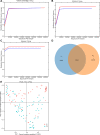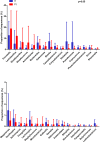Dysbiosis of urinary microbiota is positively correlated with type 2 diabetes mellitus
- PMID: 28008148
- PMCID: PMC5354796
- DOI: 10.18632/oncotarget.14028
Dysbiosis of urinary microbiota is positively correlated with type 2 diabetes mellitus
Abstract
Type 2 diabetes mellitus (T2DM) may be associated with altered urinary microbiota in female patients. We investigated alterations of urinary microbiota in Chinese female T2DM patients, and explored the associations between urinary microbiota and a patient's fasting blood glucose (FBG), urine glucose (UGLU), age, menstrual status, and body mass index (BMI). Midstream urine was collected from 70 female T2DM patients and 70 healthy females. Microbial diversity and composition were analyzed using the Illumina MiSeq sequencing platform by targeting the hypervariable V3-V4 regions of the 16S rRNA gene. We found that bacterial diversity was decreased in T2DM patients. Increased Actinobacteria phylum was positively correlated with FBG, UGLU, and BMI; Lactobacillus abundance decreased with age and menopause; and increased Lactobacillus correlated positively with FBG and UGLU. Decreased Akkermansia muciniphila was associated with FBG and UGLU. Escherichia coli abundance did not differ between the two cohorts. Carbohydrate and amino acid metabolism was reduced in T2DM patients, which were associated with bacterial richness indices such as Chao1 and ACE. Detailed microbiota analysis of well-characterized T2DM patients and healthy controls indicate that Chinese T2DM female patients exhibit dysbiosis of urinary microbiota.
Keywords: Akkermansia muciniphila; Escherichia coli; Immune response; Immunity; Immunology and Microbiology Section; lactobacillus; type 2 diabetes mellitus; urinary microbiota.
Conflict of interest statement
The authors declare no conflicts of interest.
Figures





Similar articles
-
Dysbiosis of the Urinary Microbiota Associated With Urine Levels of Proinflammatory Chemokine Interleukin-8 in Female Type 2 Diabetic Patients.Front Immunol. 2017 Aug 25;8:1032. doi: 10.3389/fimmu.2017.01032. eCollection 2017. Front Immunol. 2017. PMID: 28943876 Free PMC article.
-
Optimisation of methods for bacterial skin microbiome investigation: primer selection and comparison of the 454 versus MiSeq platform.BMC Microbiol. 2017 Jan 21;17(1):23. doi: 10.1186/s12866-017-0927-4. BMC Microbiol. 2017. PMID: 28109256 Free PMC article.
-
In-depth Microbiological Characterization of Urine From Subjects With Type 2 Diabetes.J Clin Endocrinol Metab. 2024 Dec 18;110(1):185-194. doi: 10.1210/clinem/dgae389. J Clin Endocrinol Metab. 2024. PMID: 38870276 Free PMC article.
-
A systematic review on gut microbiota in type 2 diabetes mellitus.Front Endocrinol (Lausanne). 2025 Jan 17;15:1486793. doi: 10.3389/fendo.2024.1486793. eCollection 2024. Front Endocrinol (Lausanne). 2025. PMID: 39897957 Free PMC article.
-
Circulating 16S RNA in Biofluids: Extracellular Vesicles as Mirrors of Human Microbiome?Int J Mol Sci. 2020 Nov 25;21(23):8959. doi: 10.3390/ijms21238959. Int J Mol Sci. 2020. PMID: 33255779 Free PMC article. Review.
Cited by
-
Dietary fat intake and age modulate the composition of the gut microbiota and colonic inflammation in C57BL/6J mice.BMC Microbiol. 2019 Aug 20;19(1):193. doi: 10.1186/s12866-019-1557-9. BMC Microbiol. 2019. PMID: 31429703 Free PMC article.
-
Moderation effects of food intake on the relationship between urinary microbiota and urinary interleukin-8 in female type 2 diabetic patients.PeerJ. 2020 Jan 28;8:e8481. doi: 10.7717/peerj.8481. eCollection 2020. PeerJ. 2020. PMID: 32025384 Free PMC article.
-
Dysbiosis of the Urinary Microbiota Associated With Urine Levels of Proinflammatory Chemokine Interleukin-8 in Female Type 2 Diabetic Patients.Front Immunol. 2017 Aug 25;8:1032. doi: 10.3389/fimmu.2017.01032. eCollection 2017. Front Immunol. 2017. PMID: 28943876 Free PMC article.
-
Characterization of the urinary microbiome in healthy dogs.PLoS One. 2017 May 17;12(5):e0177783. doi: 10.1371/journal.pone.0177783. eCollection 2017. PLoS One. 2017. PMID: 28545071 Free PMC article.
-
Urinary Microbiome and Psychological Factors in Women with Overactive Bladder.Front Cell Infect Microbiol. 2017 Nov 27;7:488. doi: 10.3389/fcimb.2017.00488. eCollection 2017. Front Cell Infect Microbiol. 2017. PMID: 29230385 Free PMC article.
References
-
- Rubino F. Is type 2 diabetes an operable intestinal disease? A provocative yet reasonable hypothesis. Diabetes Care. 2008;31(Suppl 2):S290–S296. - PubMed
-
- Fu AZ, Iglay K, Qiu Y, Engel S, Shankar R, Brodovicz K. Risk characterization for urinary tract infections in subjects with newly diagnosed type 2 diabetes. J Diabetes Complications. 2014;28(6):805–810. - PubMed
-
- Wilke T, Boettger B, Berg B, Groth A, Mueller S, Botteman M, Yu S, Fuchs A, Maywald U. Epidemiology of urinary tract infections in type 2 diabetes mellitus patients: An analysis based on a large sample of 456,586 German T2DM patients. J Diabetes Complications. 2015;29(8):1015–1023. - PubMed
MeSH terms
Substances
LinkOut - more resources
Full Text Sources
Other Literature Sources
Medical
Miscellaneous

